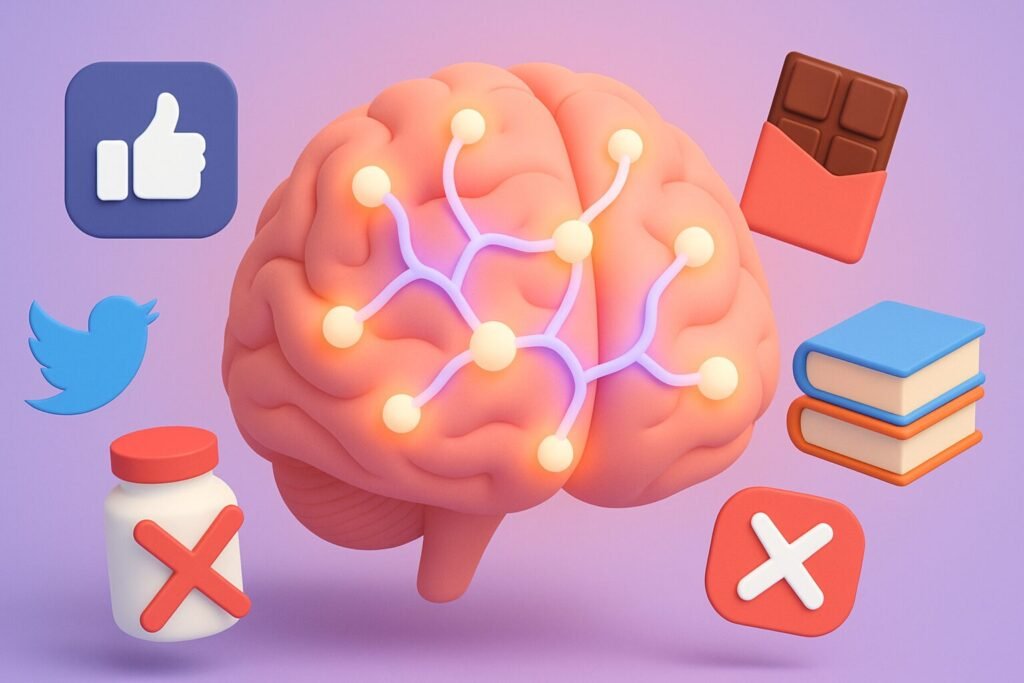
The dopamine detox trend has taken over TikTok and wellness blogs, claiming that cutting off all pleasure, from social media to sugar, can “reset” your brain. But a groundbreaking study from Northwestern University reveals the opposite: dopamine is not something to detox from, it’s something to understand. This new research shows how dopamine helps us avoid harm, stay motivated, and adapt to life’s challenges.
Table of Contents
Dopamine: More Than Just a Pleasure Signal
Most people know dopamine as the “feel-good” chemical. It gets released when you eat cake, get likes on a photo, or win a prize. But dopamine is also a powerful learning molecule that shapes how we respond to our environment.
Dopamine doesn’t just encourage you to chase rewards. It also helps you avoid negative consequences. That dual function is the subject of the new study, led by Gabriela Lopez, a doctoral candidate at Northwestern University Feinberg School of Medicine, and published in Current Biology on April 22, 2025.
“Dopamine is not all good or all bad,” Lopez said. “It rewards us for good things but also helps us tune into cues that signal trouble.”
Inside the Study: How Mice Learned to Avoid Pain
The researchers trained mice to avoid a mild aversive stimulus. Mice were placed in a two-chamber box where they could escape an unpleasant outcome by moving to the other side of the box after a five-second warning cue.
What They Measured
Scientists tracked dopamine activity in two subregions of the nucleus accumbens:
- Ventromedial shell – Associated with initial reactions to negative stimuli
- Core – Associated with learned reactions and motivational decision-making
They wanted to see how dopamine activity changed as mice went from naive to experienced at avoiding negative outcomes.
What They Found
- Ventromedial shell: Dopamine initially surged after negative events. As the mice learned to avoid them, the signal shifted to the warning cue, and eventually disappeared entirely.
- Core: Dopamine decreased in response to both the warning cue and the aversive event. This reduction grew stronger as the mice got better at avoiding the outcome.
“One area handles early learning. The other handles expert-level adaptation,” explained Dr. Talia Lerner, the study’s senior author.
When the researchers made the negative outcome unavoidable, dopamine signals reverted to their initial patterns, showing how flexible and context-sensitive dopamine truly is.
The Problem With “Dopamine Detox” Culture
Wellness trends like dopamine detoxes promote the idea that modern life overstimulates us, leading to high dopamine levels that blunt our ability to feel pleasure. The solution, they claim, is to “reset” the brain by removing all pleasurable activities.
But here’s the problem: you cannot detox from dopamine, nor should you try.
“We need dopamine to move, to sleep, to experience pleasure,” Lopez emphasized.
Dopamine is a foundational neurotransmitter, not a toxin. Attempting to starve your body of dopamine is not only scientifically incorrect, it can be dangerous. Low dopamine is linked to conditions like depression, Parkinson’s disease, and addiction relapse.
And even if you could somehow decrease your dopamine activity through abstinence, it wouldn’t teach you how to manage behaviors long-term. Dopamine isn’t just about pleasure, it’s about learning from outcomes.
Why Avoidance Learning Matters
The study’s findings also help explain something important: why some people become stuck in cycles of excessive avoidance, a key symptom in anxiety, OCD, and trauma disorders.
When dopamine systems become dysregulated, the brain can begin to overestimate the danger in a situation. This leads to avoidance behaviors that limit experiences and reduce quality of life.
“Overactive avoidance learning may also be a pathway that contributes to obsessive-compulsive disorder and other clinical anxiety disorders,” said Lopez.
Understanding dopamine’s role in adaptive and maladaptive avoidance could guide future treatments for anxiety-related disorders.
What To Do Instead of Dopamine Detoxes
While the study dismantles the foundation of dopamine detoxing, it doesn’t dismiss the idea of being more mindful of your behaviors. What people are really trying to do is gain control over compulsive or overstimulating habits.
Healthy Alternatives:
- Behavioral Experimentation: Choose one behavior to cut down on (e.g. social media). Monitor your emotions and energy throughout the change.
- Mindfulness-Based CBT: Instead of removing pleasure, use therapy to explore the underlying discomfort that fuels compulsive behaviors.
- Dopamine Replacement: Swap impulsive dopamine hits with intentional ones (e.g. a walk instead of a scroll, journaling instead of shopping).
This approach mirrors clinical techniques used in Cognitive Behavioral Therapy (CBT), which has been proven to work for habit change and emotional regulation.
The Science of Flexibility and Adaptation
What makes this study so powerful is its proof that dopamine activity is fluid, not fixed. It adapts based on context, experience, and perceived control.
This adaptability is exactly what wellness influencers get wrong. Your brain doesn’t need a total shutdown. It needs structure, boundaries, and a better understanding of which cues are meaningful.
“Dopamine helps us continuously adapt our learning strategies in unstable environments,” Lopez said.
In other words: dopamine is a teacher, not a villain.
Final Thoughts: The Future of Brain-Based Habit Change

Instead of detoxing your dopamine, learn to work with it. This study reminds us that true clarity and focus come from understanding the brain’s natural cycles, not trying to override them.
If you’re trying to reclaim your focus or break a digital addiction, forget extreme fasts and instead:
- Track your triggers
- Introduce small replacements
- Practice flexibility
- Lean on support systems
The Northwestern research doesn’t just debunk a fad, it opens the door for more intelligent, compassionate approaches to mental clarity





